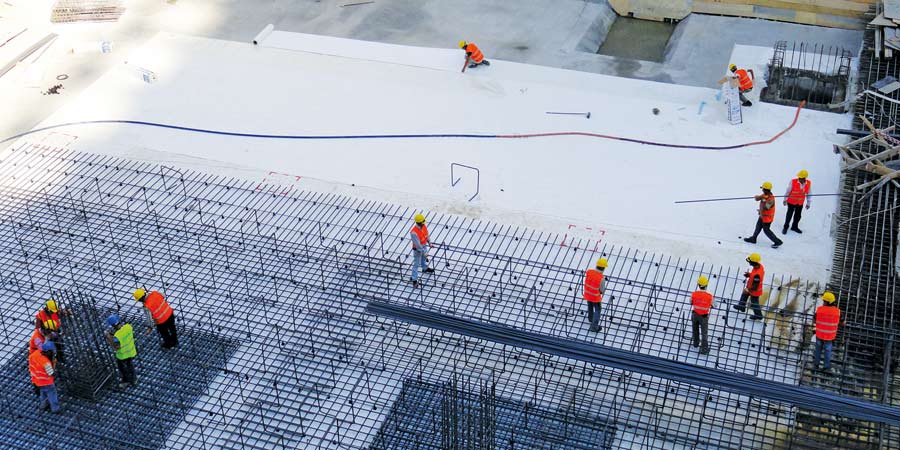
Pre-applied waterproofing is used below basement slabs and behind walls on job sites where there is limited space for excavation and heavy equipment. Instead of pouring the foundation and then applying waterproofing to the outside of the foundation wall, pre-applied waterproofing is placed before the foundation is poured. The slab and wall concrete is then cast on top of the membrane.
A bonded pre-applied waterproofing membrane (also called a blindside membrane) must seal tightly to the concrete in order to prevent lateral water migration between the membrane and the structural concrete. It has to be able to stay in place, even if the concrete cracks or the soil beneath it begins to settle.
Types of waterproofing bonding
There are two different ways that waterproofing membranes adhere to concrete:
A mechanical bond and an adhesive bond.
With a mechanical bond, the membrane typically has one side that has fleece or mesh on it. As the concrete hardens, the bristles of the fleece attach to the concrete. This provides a certain level of bonding so that the membrane cannot be detached. However, the bond does not necessarily form an intimate watertight seal. Like the bristle of a brush, the bristles have gaps and this creates capillaries for water to migrate through.
With a pressure sensitive adhesive bond, there is an intimate and continuous adhesion that aggressively seals the concrete and the membrane together.
Shortcomings of mechanically bonded waterproofing membranes
With a membrane that uses mechanical bonding, it has been demonstrated that even if the membrane is firmly attached to the concrete, water can still track between the membrane and the concrete in all directions, in search of cracks or other weaknesses. Leaks can be sealed from the inside, but the water will keep tracking under pressure to find more ways into the structure. In general, adhesives used in such membranes serve only to attach the fleece to the carrier film and offer no additional waterproofing resistance.
Advantages of adhesive bonding
A fully bonded adhesive membrane creates an integral seal between the concrete and the waterproofing membrane so that in the event of a breach in the membrane, water is prevented from passing the membrane and migrating. This means that water remains excluded, so that in the worst case of a breach coinciding with a crack or weakness in the concrete, leaks can be localized and fixed quickly, resulting in lower remedial measures or maintenance costs during the life of the structure.
How the PREPRUFE® pre-applied waterproofing membrane works
The PREPRUFE® pre-applied waterproofing membrane is a fully bonded adhesive membrane. The bond is continuous below the slab and behind the walls, to form a fully sealed structure. This seal prevents the lateral migration of water into and around the structure. If a breach occurs, the membrane ensures that water under hydrostatic pressure is unable to migrate between the membrane and the concrete, limiting the risk of waterproofing failure. Independent testing shows the PREPRUFE® waterproofing membrane can resist lateral water migration at pressures in excess of 70 meters head of water.
Learn more about PREPRUFE® Plus waterproofing membrane
Related articles
August 24, 2018
Understanding gas vapor remediation
Developers are increasingly facing the challenge of protecting new structures from harmful gases in the soil. Even when layers of soil are removed from industrial sites and other brownfields, gas barr...
READ MOREMarch 28, 2018
Waterproofing structures in extreme climates
Poised at the end of Doha Bay, the Museum of Islamic Art rises from the waters of the Arabian Gulf. The climate and corrosive salt environment of the Persian Gulf created a number of challenges for th...
READ MOREApril 03, 2018
Providing mission-critical waterproofing
Many structures need to be waterproofed to protect against deterioration, but what if you have a building that needs to be kept very dry? How do you safeguard critical property and assets from water i...
READ MOREMay 14, 2018
Specifying below grade waterproofing
Waterproofing basements and other below grade spaces takes special considerations. Here are five points to consider when specifying waterproofing for these spaces. Investigate the water table l...
READ MORESeptember 24, 2018
Digging deep: Deep foundation design challenges
With space at a premium in many urban areas, developers are digging deeper foundations to increase the square footage of residential, commercial, and mixed-use building projects. In Dubai for example,...
READ MORETags
- PREPRUFE PLUS
- Waterproofing